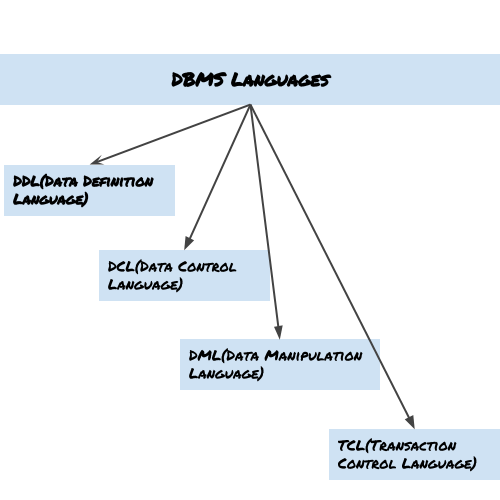Database languages are used to read, update and store data in a database. There are several such languages that can be used for this purpose; one of them is SQL (Structured Query Language).
Types of DBMS languages:

Data Definition Language (DDL)
DDL is used for specifying the database schema. It is used for creating tables, schema, indexes, constraints etc. in database. Lets see the operations that we can perform on database using DDL:
- To create the database instance – CREATE
- To alter the structure of database – ALTER
- To drop database instances – DROP
- To delete tables in a database instance – TRUNCATE
- To rename database instances – RENAME
- To drop objects from database such as tables – DROP
- To Comment – Comment
All of these commands either defines or update the database schema that’s why they come under Data Definition language.
Data Manipulation Language (DML)
DML is used for accessing and manipulating data in a database. The following operations on database comes under DML:
- To read records from table(s) – SELECT
- To insert record(s) into the table(s) – INSERT
- Update the data in table(s) – UPDATE
- Delete all the records from the table – DELETE
Data Control language (DCL)
DCL is used for granting and revoking user access on a database –
- To grant access to user – GRANT
- To revoke access from user – REVOKE
In practical data definition language, data manipulation language and data control languages are not separate language, rather they are the parts of a single database language such as SQL.
Transaction Control Language(TCL)
The changes in the database that we made using DML commands are either performed or rollbacked using TCL.
- To persist the changes made by DML commands in database – COMMIT
- To rollback the changes made to the database – ROLLBACK
Fahad says
You guys are really awesome,
Thanks a lots for this valuable information about DBMS,
Well DBMS is a brief topic and very hard to remember,
Thank for making DBMS easy
habibur says
Why SQL is taken for instance to categories DDL?
Is the SQL a sub category of DDL?
I’m not clear.
Sakhawat says
DDL and DML and Query Languages are the mode of database language. On the other hand SQL is the example of Database language, not a subcategory of DDL.